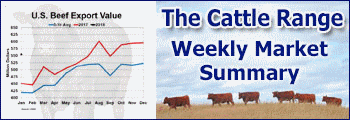May ‘World Agricultural Supply and Demand Estimates’
LIVESTOCK & POULTRY:
Total U.S. red meat and poultry production for 2025 is forecast to be lower than 2024. Beef production is forecast lower as tighter cattle supplies and increased heifer and cow retention are expected to result in lower slaughter of both fed and non-fed cattle. Pork production is forecast to increase as growth in pigs per litter will more than offset fewer expected farrowings. Broiler production is expected to increase as lower feed costs and tighter red meat supplies support steady growth. Turkey production is forecast to increase, as it recovers from Highly Pathogenic Avian Influenza (HPAI)-related culls.
Total red meat and poultry production forecasts for 2024 are reduced from last month, with lower broiler, turkey, and pork forecasts offset slightly by higher beef production. Beef production is raised on higher cattle slaughter in the second half of the year and heavier dressed weights. Pork production is lower as higher slaughter in the first half of the year is more than offset by lighter expected dressed weights for the duration of 2024. Broiler production is lower based on slaughter data through the first quarter, with the forecast for the remainder of the year unchanged. Turkey production is lowered reflecting slaughter as well as hatchery data and expectations that weaker returns will put downward pressure on production for the second half of the year.
For 2025, beef exports are forecast lower than 2024 as tight domestic supplies limit competitiveness. Beef imports are higher due to tight beef domestic supplies, particularly for processing-grade beef. Pork exports are forecast higher on improved price competitiveness and increased demand in several key markets. Broiler exports are higher due to greater supplies, but growth is expected to be constrained by competition from other major exporters. Turkey exports are forecast to be slightly higher as supplies increase.
For 2024, the beef export forecast is raised from last month on data reported through the first quarter. Beef imports are lowered slightly on first-quarter data, but the forecasts for the remaining quarters are unchanged. Pork exports are lowered based on recent trade data and slower-than-expected demand growth in several key markets. Broiler exports are lowered on recent data and increased price competition from major exporters.
For 2025, cattle prices are above 2024 on tighter cattle and beef supplies. Hog prices are lower than 2024 on increased expected hog supplies. Broiler prices are forecast slightly lower due to increased production. Turkey prices are higher.
Cattle prices in 2024 are lowered on recent data and a more rapid pace of marketing in the second half of the year. Hog prices are lowered on weaker-than-expected demand in the second half of the year. Broiler and turkey prices are lowered on recent data and softer expected demand.
COARSE GRAINS:
The 2024/25 U.S. corn outlook is for larger supplies, greater domestic use and exports, and higher ending stocks. The corn crop is projected at 14.9 billion bushels, down 3 percent from last year’s record as a decline in area is partially offset by an increase in yield. The yield projection of 181.0 bushels per acre is based on a weather-adjusted trend assuming normal planting progress and summer growing season weather, estimated using the 1988-2023 time period. With higher beginning stocks, total corn supplies are forecast at 16.9 billion bushels, the highest since 2017/18.
Total U.S. corn use for 2024/25 is forecast to rise just under 1 percent relative to a year ago on higher domestic use and exports. Food, seed, and industrial use is forecast at 6.9 billion bushels. Corn used for ethanol is unchanged relative to a year ago, based on expectations of essentially flat motor gasoline consumption. Feed and residual use is projected higher on larger supplies and lower expected prices.
U.S. corn exports for 2024/25 are forecast to rise 50 million bushels to 2.2 billion, supported by a combined 5.4-million-ton reduction in exports for Argentina, Brazil, Russia, and Ukraine. The United States is projected to be the world’s largest exporter for the second consecutive year, with an expected increase in global market share.
With total U.S. corn supply rising more than use, 2024/25 ending stocks are up 80 million bushels from last year and, if realized, would be the highest in absolute terms since 2018/19. Stocks would represent 14.2 percent of use, up from 13.7 percent the prior year and the highest since 2019/20. The season-average farm price is projected at $4.40 per bushel, down 25 cents from 2023/24.
WHEAT:
The outlook for 2024/25 U.S. wheat is for larger supplies, modestly higher domestic use, increased exports, and higher stocks. Supplies are projected up 6 percent from 2023/24 on larger carry-in stocks and production. All wheat production is projected at 1,858 million bushels, up 3 percent from last year on higher harvested acreage and yields. The all wheat yield is projected at 48.9 bushels per acre, up 0.3 bushels. The first 2024 NASS survey-based winter wheat production forecast of 1,278 million bushels is up 2 percent from 2023 on increased Hard Red Winter and White Winter production more than offsetting lower Soft Red Winter production. Total 2024/25 domestic use is projected up 1 percent, primarily on higher feed and residual use. Exports are projected at 775 million bushels, up 55 million from the revised 2023/24 exports, which remain at a 52-year low. Increased U.S. exportable supplies and more competitive prices are expected to result in higher exports. Projected 2024/25 ending stocks are 11 percent above last year at 766 million bushels, the highest level in four years. The projected 2024/25 season-average farm price (SAFP) is $6.00 per bushel, down $1.10 from last year’s SAFP on higher stocks and lower projected U.S. corn prices.














